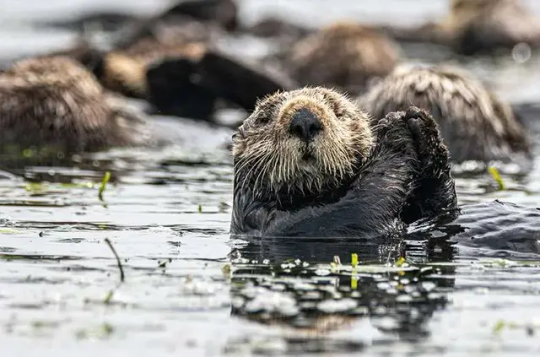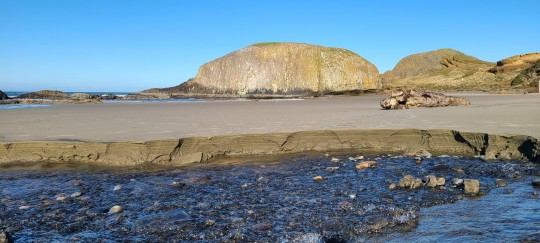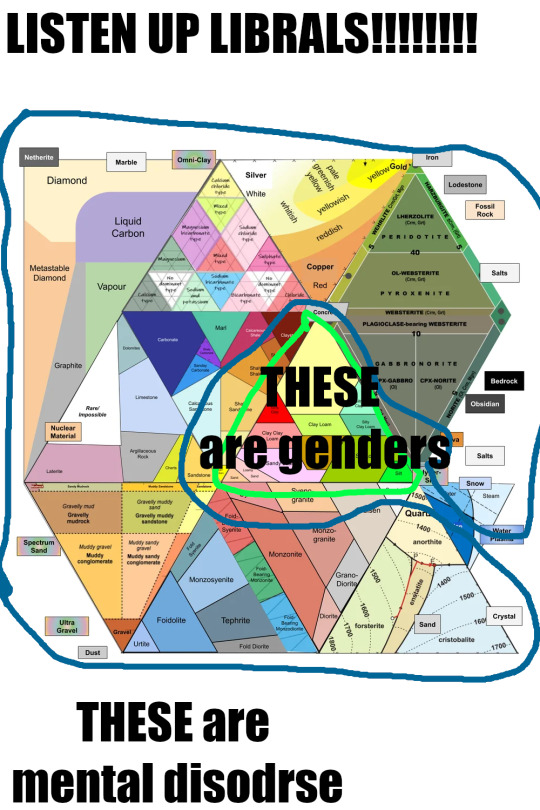#soil erosion
Text
"Many people know about the Yellowstone wolf miracle. After wolves were reintroduced to the national park in the mid-1990s, streamside bushes that had been grazed to stubble by out-of-control elk populations started bouncing back. Streambank erosion decreased. Creatures such as songbirds that favor greenery along creeks returned. Nearby aspens flourished.
While there is debate about how much of this stemmed from the wolves shrinking the elk population and how much was a subtle shift in elk behavior, the overall change was dramatic. People were captivated by the idea that a single charismatic predator’s return could ripple through an entire ecosystem. The result was trumpeted in publications such as National Geographic.
But have you heard about the sea otters and the salt marshes? Probably not.
It turns out these sleek coastal mammals, hunted nearly to extinction for their plush pelts, can play a wolf-like role in rapidly disappearing salt marshes, according to new research. The findings highlight the transformative power of a top predator, and the potential ecosystem benefits from their return.
“It begs the question: In how many other ecosystems worldwide could the reintroduction of a former top predator yield similar benefits?” said Brian Silliman, a Duke University ecologist involved in the research.
The work focused on Elk Slough, a tidal estuary at the edge of California’s Monterey Bay. The salt marsh lining the slough’s banks has been shrinking for decades. Between 1956 and 2003, the area lost 50% of its salt marshes.
Such tidal marshes are critical to keeping shorelines from eroding into the sea, and they are in decline around the world. The damage is often blamed on a combination of human’s altering coastal water flows, rising seas and nutrient pollution that weakens the roots of marsh plants.
But in Elk Slough, a return of sea otters hinted that their earlier disappearance might have been a factor as well. As many as 300,000 sea otters once swam in the coastal waters of western North America, from Baja California north to the Aleutian Islands. But a fur trade begun by Europeans in the 1700s nearly wiped out the animals, reducing their numbers to just a few thousand by the early 1900s. Southern sea otters, which lived on the California coast, were thought to be extinct until a handful were found in the early 1900s.
In the late 1900s, conservation organizations and government agencies embarked on an effort to revive the southern sea otters, which remain protected under the Endangered Species Act. In Monterey Bay, the Monterey Bay Aquarium selected Elk Slough as a prime place to release orphaned young sea otters taken in by the aquarium.
As the otter numbers grew, the dynamics within the salt marsh changed. Between 2008 and 2018, erosion of tidal creeks in the estuary fell by around 70% as otter numbers recovered from just 11 animals to nearly 120 following a population crash tied to an intense El Niño climate cycle.
While suggestive, those results are hardly bulletproof evidence of a link between otters and erosion. Nor does it explain how that might work.
To get a more detailed picture, the researchers visited 5 small tidal creeks feeding into the main slough. At each one, they enclosed some of the marsh with fencing to keep out otters, while other spots were left open. Over three years, they monitored the diverging fates of the different patches.
The results showed that otter presence made a dramatic difference in the condition of the marsh. They also helped illuminate why this was happening. It comes down to the otters’ appetite for small burrowing crabs that live in the marsh.

Adult otters need to eat around 25% of their body weight every day to endure the cold Pacific Ocean waters, the equivalent of 20 to 25 pounds. And crabs are one of their favorite meals. After three years, crab densities were 68% higher in fenced areas beyond the reach of otters. The number of crab burrows was also higher. At the same time, marsh grasses inside the fences fared worse, with 48% less mass of leaves and stems and 15% less root mass, a critical feature for capturing sediment that could otherwise wash away, the scientists reported in late January in Nature.
The results point to the crabs as a culprit in the decline of the marshes, as they excavate their holes and feed on the plant roots. It also shows the returning otters’ potential as a marsh savior, even in the face of rising sea levels and continued pollution. In tidal creeks with high numbers of otters, creek erosion was just 5 centimeters per year, 69% lower than in creeks with fewer otters and a far cry from earlier erosion of as much as 30 centimeters per year.
“The return of the sea otters didn’t reverse the losses, but it did slow them to a point that these systems could restabilize despite all the other pressures they are subject to,” said Brent Hughes, a biology professor at Sonoma State University and former postdoctoral researcher in Silliman’s Duke lab.
The findings raise the question of whether other coastal ecosystems might benefit from a return of top predators. The scientists note that a number of these places were once filled with such toothy creatures as bears, crocodiles, sharks, wolves, lions and dolphins. Sea otters are still largely absent along much of the West Coast.
As people wrestle to hold back the seas and revive their ailing coasts, a predator revival could offer relatively cheap and effective assistance. “It would cost millions of dollars for humans to rebuild these creek banks and restore these marshes,” Silliman said of Elk Slough. “The sea otters are stabilizing them for free in exchange for an all-you-can-eat crab feast.”"
-via Anthropocene Magazine, February 7, 2024
#otters#sea otters#conservation#erosion#coastal erosion#coastline#marshes#saltwater#marine science#marine biology#marine animals#sea creatures#ocean#sustainability#soil erosion#erosion control#crab#good news#hope
3K notes
·
View notes
Text

As above, so below. The same erosion taking place over thousands of years to the sandstone cliffs in the background can be seen over the course of minutes in the sand lining the stream in front of it
9 notes
·
View notes
Text
Billionaire’s Nantucket Beach House Swept Away
#billionaire#nantucket#beach house#swept away#soil erosion#coastal erosion#climate change#global warming#karma#bigot#republican hypocrisy#liberal hypocrisy#hypocrite#gop hypocrisy#jerktrillionaires#jerkbillionaires#jerkmillionaires#earth#econotego#class war#eat the rich#eat the fucking rich#fascist#capitalism#anti capitalist#capitalist hell#capitalist dystopia#capitalist bullshit#ecology#ausgov
4 notes
·
View notes
Text
Lawns and Variation
Lawns most often consist of grasses and clover kept short by mowing. For decades in the United States of America, they were an important aspect of conformity. To this day, lawn maintenance is a key focus of many Homeowner Associations (HOAs). Through media and HOA policies, lawns grown out of control are associated with neglected land and poverty.
A short, well-kept lawn can be very aesthetically pleasing. It also reduces concerns about ticks and other pests. Maintaining one through regular mowing can provide homeowners a reason to spend time outside, and be part of important routines that help people keep their lives on track. Additionally, a short lawn is ideal for outside activities for pets, children, and adults. Of course, not maintaining one’s lawn can also lead to fines if part of an HOA.
The negatives of monoculture lawns, however, far outweigh the potential benefits.
The Negatives
Reducing biodiversity is the best-known way in which typical lawns cause damage. Persistent mowing keeps many species of plants from succeeding. Low biodiversity directly contributes to low ecosystem resilience1. For example, when a pest or fungus comes along that wipes out one type of plant, an entire field or dozens of fields will be wiped out because they are all the same plant. That leaves the land susceptible to erosion, flooding, and desertification (i.e arid land).
Low biodiversity means worse conditions for other forms of life, as well. Regular mowing to keep the grass short and uniform also keeps different floral plants from growing, thus reducing resources for pollinators1.
Persistent mowing also acts as an unnecessary addition to greenhouse gas production. Gas-powered lawn equipment contributes significantly to CO2, NOx, and volatile organic compound (VOC) emissions3. The amount of carbon equivalent pollution from lawn mowing and fertilizer use more than negates the benefit of carbon sequestration (CO2 kept out of the atmosphere) in grass yards2.
For many, yard maintenance also involves fertilizer and pesticide use. Fertilizer use contaminates waterways, primarily through rainfall, and causes algal blooms and decreased oxygenation in waterways. Pesticides can also pollute waterways. In fact, a majority of applied pesticides end up in soil, water, and air, and end up entering the food chain where they negatively affect a wide range of animals, including humans5. Pesticide contamination in humans has been linked to conditions like cancers, neurological issues, obesity, and neurological issues, to name a few5.
Lastly, lawns can need excessive amounts of water. On average, about 9 billion gallons of water goes to watering lawns in the U.S.A. every day6. This is made worse by poor watering practices, causing much of that water to be lost to evaporation and runoff. Water is considered a renewable resource, but that is contingent on proper maintenance and management.
Grass lawns around the world consume an abundance of resources and toxic materials to maintain. Maintaining a grass lawn is ecologically harmful because of pesticides, fertilizers, petroleum pollution, low biodiversity, erosion, and water use.
Cultivating native flora instead nullifies the need for these measures. Native plants are physiologically adapted to the local climate and conditions, and thus need less, if any, watering7. They are less likely to need pesticides or fertilizers, and their deeper root systems decrease soil erosion8. The reduced use of lawn equipment vastly improves air quality, and provides a much more interesting view than a monoculture yard8.
Clover
Transitioning a lawn from short, uniform grasses into a more biodiverse, environmentally healthy yard can be very difficult, and potentially impossible for some people. It doesn’t have to be all or nothing, though. Fostering the growth of clovers instead of grasses, for example, can be a good step for your soil.
Clovers include about 300 species with native varieties in many parts of the world, including Europe, central Asia, North America, and Africa. Clovers generally need minimal maintenance and, if allowed to flower, provide valuable resources for native pollinators9. Clover is also esteemed for its nitrogen-fixing properties. Like many legumes, clover species pull nitrogen from the atmosphere and increase nitrogen availability in soil10.
Converting grass lawns into areas for various native flora has many benefits for the environment and the land-owner, who can enjoy beautiful flowers and bushes while improving air and water quality. While a clover lawn is not as beneficial in these aspects, they can still be an important way for people to start improving their lawn. Fortunately, many more websites now exist to guide land-owners in cultivating native plants. There is always something you can do to help.
Additional Resources
1. https://besjournals.onlinelibrary.wiley.com/doi/pdf/10.1111/1365-2664.13542
2. https://link.springer.com/article/10.1007/s00267-012-9967-6
3. https://www.epa.gov/sites/default/files/2015-09/documents/banks.pdf
4. https://www.ctahr.hawaii.edu/kaufmana/downloads/Kaufman%20Lawn.pdf
5. https://link.springer.com/article/10.1007/s40726-018-0092-x
6. https://19january2017snapshot.epa.gov/www3/watersense/pubs/outdoor.html
7.https://www.montvillenj.org/DocumentCenter/View/155/Choose-Plants-That-Are-Native-to-the-Area-That-Are-Drought-Resistant-PDF?bidId=#
8. https://archive.epa.gov/greenacres/web/html/index.html#
9. https://www.oneearth.org/the-various-advantages-of-clover/
10. https://onlinelibrary.wiley.com/doi/pdf/10.1002/its2.19
11. https://www.sciencedirect.com/science/article/pii/S1618866715000436
#monoculture#lawns#suburban lawns#grass#clover#flowers#flora#climate change#environment#resources#research#article#soil erosion#runoff#pesticides#fertilizer#planting#garden#biodiversity#ecological resistance
5 notes
·
View notes
Text

did i find this on the internet? did one of my conservative family members send this to me? did i make it? who knows!
#196#shitposting#soil#soil erosion#soil compass memes#soil compass > political compass dont @ me#queer
3 notes
·
View notes
Text

Heavy spring rain physically breaks down exposed soil leading to soil erosion. Year-round ground cover protects the soil surface and enhances infiltration. Supplemental tile drainage increases infiltration and flow of water to reduce ponding. Drainage from this field with perennial grasses runs clear after days of saturating rains.
1 note
·
View note
Text
soil erosion
0 notes
Text
I be making evil sourdough starter (soil bacteria culture)
1 note
·
View note
Text
https://hakaimagazine.com/videos-visuals/the-water-is-eating-the-island/
0 notes
Text
Savinaya Infratech's Innovations in Slope Stability: Unveiling Tomorrow's Foundations Today
Embark on a journey of innovation with Savinaya Infratech's soil nail solutions, designed to redefine the parameters of slope stability. Our company's forward-thinking approach and cutting-edge technologies ensure that your projects are equipped with the latest advancements in slope engineering. Discover the future of stability with Savinaya Infratech.
0 notes
Link
1 note
·
View note
Text

Welcome to Green Plants outdoor, where we bring nature's beauty right to your doorstep. Whether you're a seasoned gardener or just starting your green journey, we have everything you need to cultivate your own personal oasis. https://nehachoudhary.com/
#flowers#landscape#gardening#plants#welcome home#green plants#nursery#blooms#nature#agriculture#soil#soil erosion
1 note
·
View note
Text
"Discover how to select the ideal soil for your garden with insights on types, texture, pH, plant needs, and sustainable practices. Get expert gardening tips now!"
0 notes
Text

Suffering from yard drainage issues in Atlanta? Erosion Management Services provide yard drainage Atlanta solutions that tackle water pooling, soil erosion, and other landscape problems. Their expert team designs and installs custom drainage systems to protect your property, enhance its beauty, and save you time and money. Request a consultation today. Visit now.
0 notes
